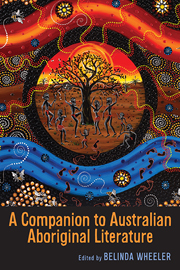Book contents
- Frontmatter
- Contents
- Foreword
- Acknowledgments
- Chronology
- Introduction: The Emerging Canon
- 1 Indigenous Life Writing: Rethinking Poetics and Practice
- 2 Australian Aboriginal Life Writers and Their Editors: Cross-Cultural Collaboration, Authorial Intention, and the Impact of Editorial Choices
- 3 Contemporary Life Writing: Inscribing Double Voice in Intergenerational Collaborative Life-Writing Projects
- 4 European Translations of Australian Aboriginal Texts
- 5 Tracing a Trajectory from Songpoetry to Contemporary Aboriginal Poetry
- 6 Rites/Rights/Writes of Passage: Identity Construction in Australian Aboriginal Young Adult Fiction
- 7 Humor in Contemporary Aboriginal Adult Fiction
- 8 White Shadows: The Gothic Tradition in Australian Aboriginal Literature
- 9 Bold, Black, and Brilliant: Aboriginal Australian Drama
- 10 The “Stolen Generations” in Feature Film: The Approach of Aboriginal Director Rachel Perkins and Others
- 11 A History of Popular Indigenous Music
- Notes on the Contributors
- Index
11 - A History of Popular Indigenous Music
Published online by Cambridge University Press: 05 September 2013
- Frontmatter
- Contents
- Foreword
- Acknowledgments
- Chronology
- Introduction: The Emerging Canon
- 1 Indigenous Life Writing: Rethinking Poetics and Practice
- 2 Australian Aboriginal Life Writers and Their Editors: Cross-Cultural Collaboration, Authorial Intention, and the Impact of Editorial Choices
- 3 Contemporary Life Writing: Inscribing Double Voice in Intergenerational Collaborative Life-Writing Projects
- 4 European Translations of Australian Aboriginal Texts
- 5 Tracing a Trajectory from Songpoetry to Contemporary Aboriginal Poetry
- 6 Rites/Rights/Writes of Passage: Identity Construction in Australian Aboriginal Young Adult Fiction
- 7 Humor in Contemporary Aboriginal Adult Fiction
- 8 White Shadows: The Gothic Tradition in Australian Aboriginal Literature
- 9 Bold, Black, and Brilliant: Aboriginal Australian Drama
- 10 The “Stolen Generations” in Feature Film: The Approach of Aboriginal Director Rachel Perkins and Others
- 11 A History of Popular Indigenous Music
- Notes on the Contributors
- Index
Summary
We're talking about building bridges, and
there's nothing like music to unite people.
—Mandawuy YunupinguSince the invention of recording technologies like the phonograph in the late 1800s, Indigenous music has been performed and recorded across Australia for a wide range of audiences. In the early twentieth century, for instance, music was recorded by anthropologists keen to capture the sounds of a culture that was believed to be in rapid decline (Thomas). Individual performers were not considered important in these recordings; their music was produced for scientific posterity rather than popular pleasure. And even though Aboriginal participation in local music festivals, touring vaudeville shows, and community gatherings was well documented throughout the twentieth century, it was not until the 1950s that Indigenous “pop stars” began to sell records for mass consumption (Dunbar-Hall and Gibson). Yet, with the persistence of recording artists like Jimmy Little over the past sixty years, Indigenous musicians have steadily gained prominence in Australia's mainstream. This has been particularly true of the past twenty years, especially since the Sydney Olympics, where promotional strategies have brought about a new popular pride in musical achievements, based upon a celebrated history of diverse sounds and voices.
- Type
- Chapter
- Information
- A Companion to Australian Aboriginal Literature , pp. 187 - 202Publisher: Boydell & BrewerPrint publication year: 2013



